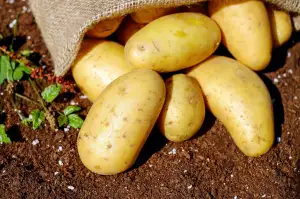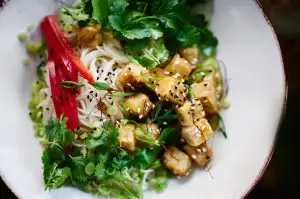Master the Art of Julienne Cut: Elevate Your Culinary Skills with Thin and Beautiful Strips

- Benefits of using the julienne cut technique
- Tools required for julienne cutting
- Step-by-step guide to julienne cutting
- Tips for achieving perfect julienne cuts
- Popular recipes that incorporate julienne cut vegetables
- Variations of the julienne cut technique
- Frequently asked questions about julienne cutting
The julienne cut is a culinary technique that involves cutting vegetables or fruits into long, thin strips. It is named after the French word "julienne," which means "thin strips." This technique not only adds an elegant touch to your dishes but also enhances their texture and presentation. Whether you're a home cook or a professional chef, mastering the art of julienne cutting will elevate your culinary skills and take your dishes to the next level. So let's dive in and explore the world of julienne cutting!
Benefits of using the julienne cut technique
The julienne cut technique offers several benefits that can elevate your culinary skills. Firstly, it enhances the presentation of your dishes by creating thin and beautiful strips of vegetables. These delicate cuts add a touch of elegance to any plate.
Secondly, julienne cutting ensures even cooking and allows for quick and uniform heat penetration. The thin strips cook faster than larger chunks, making them perfect for stir-fries, sautés, and other quick-cooking methods.
Additionally, the julienne cut technique maximizes the flavor absorption of vegetables. The smaller surface area of the strips allows them to absorb marinades, sauces, and seasonings more effectively, resulting in a well-balanced and flavorful dish.
Lastly, using the julienne cut technique can help you incorporate more vegetables into your meals. By transforming vegetables into appealing strips, you can make them more enticing for picky eaters or those who are not fond of eating large chunks of vegetables.
Overall, mastering the art of julienne cutting will not only enhance the visual appeal of your dishes but also improve their taste and texture while promoting a healthier and more balanced diet.
Tools required for julienne cutting
To achieve perfect julienne cuts, you will need a few essential tools. The first tool is a sharp chef's knife. A sharp knife ensures clean cuts and reduces the risk of accidents. Additionally, a mandoline slicer or a julienne peeler can be used to create uniform strips effortlessly. These tools allow for precise cutting and save time in the kitchen. Lastly, a cutting board with a stable surface is necessary to provide stability while slicing. With these tools at hand, you'll be well-equipped to master the art of julienne cutting.
Step-by-step guide to julienne cutting
1. Start by selecting a firm and fresh vegetable, such as a carrot or zucchini, for julienne cutting.
2. Peel the vegetable using a peeler or knife to remove the outer skin.
3. Trim off the ends of the vegetable to create a flat surface.
4. Hold the vegetable firmly with one hand and use a sharp knife to make vertical cuts, creating thin slices that are about 1/8 inch thick.
5. Stack the slices together and cut them into long, thin strips that are approximately 1/8 inch wide.
6. To achieve uniform julienne cuts, try to maintain consistent thickness throughout the process.
7. Repeat these steps with other vegetables you want to julienne cut, ensuring they are all of similar size for even cooking.
By following this step-by-step guide, you will be able to master the art of julienne cutting and create beautiful, thin strips of vegetables for your culinary creations.
Tips for achieving perfect julienne cuts
1. Use sharp knives: A sharp knife is essential for clean and precise cuts. Dull knives can crush the vegetables, resulting in uneven strips.
2. Practice knife skills: Take the time to practice your knife skills before attempting julienne cutting. This will help you develop the necessary control and precision.
3. Choose the right vegetables: Certain vegetables like carrots, zucchini, and bell peppers work best for julienne cutting due to their firm texture. Select fresh and firm produce for better results.
4. Trim the vegetables: Before cutting, make sure to trim off any uneven edges or ends of the vegetables. This will provide a stable base for cutting uniform strips.
5. Maintain consistent size: To achieve even julienne cuts, it's important to maintain a consistent size throughout the vegetable. Aim for strips that are approximately 1/8 inch thick and 2-3 inches long.
6. Use a mandoline or julienne peeler: If you struggle with consistency, consider using a mandoline or julienne peeler. These tools can help you achieve uniform cuts effortlessly.
7. Practice safety precautions: When working with sharp knives, always prioritize safety. Keep your fingers curled under while cutting and use a cutting board with a non-slip surface to prevent accidents.
8. Take your time: Rushing through the process can lead to sloppy cuts. Be patient and take your time when julienning vegetables, ensuring each strip is carefully cut.
By following these tips, you'll be well on your way to mastering the art of perfect julienne cuts in no time!
Popular recipes that incorporate julienne cut vegetables
Popular recipes that incorporate julienne cut vegetables include stir-fries, salads, and spring rolls. In stir-fries, the thin strips of vegetables cook quickly and evenly, adding a vibrant crunch to the dish. Salads benefit from the julienne cut as it creates visually appealing and easy-to-eat vegetable ribbons. Spring rolls are enhanced with julienne cut vegetables, providing a fresh and crunchy texture to complement the other ingredients. Try these recipes to showcase your mastery of the art of julienne cutting!
Variations of the julienne cut technique
Variations of the julienne cut technique offer exciting ways to add creativity and diversity to your dishes. Here are a few popular variations:
1. Fine Julienne: This variation involves cutting vegetables into even thinner strips, creating delicate and elegant textures. It works well for garnishing salads or adding a touch of sophistication to soups.
2. Batonnet: Similar to the julienne cut, batonnet involves cutting vegetables into thicker, rectangular strips. These larger pieces are perfect for stir-fries or as a side dish when you want more substantial bites.
3. Allumette: Allumette is a French term meaning "matchstick." In this variation, vegetables are cut into long, thin strips that resemble matchsticks. They are commonly used in Asian stir-fries and noodle dishes.
4. Paysanne: The paysanne cut involves slicing vegetables into small, square shapes rather than long strips. This variation adds visual appeal and can be used in vegetable medleys or sautés.
By exploring these variations, you can elevate your culinary creations and impress your guests with visually stunning and delicious dishes.
Frequently asked questions about julienne cutting
1. What is the difference between julienne and matchstick cuts?
Julienne cuts are thin, long strips that are typically 1/8 inch thick and 2 inches in length. Matchstick cuts are slightly thicker and shorter, usually around 1/4 inch thick and 1 inch in length.
2. Can I use any type of vegetable for julienne cutting?
Yes, you can use a variety of vegetables such as carrots, zucchini, bell peppers, and even potatoes for julienne cutting. However, it's important to choose firm vegetables that can hold their shape when cut into thin strips.
3. Do I need a special knife for julienne cutting?
While there are specialized julienne knives available, you can achieve the same results with a sharp chef's knife or a mandoline slicer with a julienne blade attachment.
4. How do I prevent my fingers from getting cut while julienning?
To avoid accidents, always keep your fingers curled inwards while holding the vegetable and make sure to use a stable cutting board. If you're uncomfortable with hand-cutting, consider using a safety holder or protective gloves.
5. Can I store julienned vegetables in advance?
It's best to cut vegetables just before using them to maintain their freshness and texture. However, if necessary, you can store julienned vegetables in an airtight container lined with paper towels for up to 24 hours in the refrigerator.
6. Are there any alternative techniques for achieving similar results?
If you don't have the time or tools for julienne cutting, you can use a grater or spiralizer to create thin strips of vegetables that will still add texture and flavor to your dishes.
Mastering the art of julienne cutting will not only elevate your culinary skills but also enhance the visual appeal of your dishes. With practice and patience, you'll soon be creating beautiful, thin strips that will impress both your family and guests. So grab your knife and get ready to julienne like a pro!
Mastering the art of julienne cutting is a valuable skill that can elevate your culinary expertise to new heights. By learning this technique, you can transform ordinary vegetables into thin and beautiful strips, adding both visual appeal and texture to your dishes.
Not only does the julienne cut enhance the presentation of your meals, but it also allows for even cooking and quicker preparation. The uniformity of the strips ensures that each piece cooks at the same rate, resulting in perfectly cooked vegetables every time.
To achieve the best results, it is important to have the right tools on hand. A sharp chef's knife and a sturdy cutting board are essential for precise cuts. Additionally, investing in a julienne peeler or mandoline slicer can make the process even easier and more efficient.
Follow our step-by-step guide and implement our tips for achieving perfect julienne cuts. With practice, you will become more confident in your ability to create these delicate strips effortlessly.
The versatility of the julienne cut opens up a world of possibilities in your kitchen. Incorporate these thin vegetable strips into popular recipes like stir-fries, salads, spring rolls, or garnishes for soups and stews. The added crunch and vibrant colors will take your dishes from ordinary to extraordinary.
While traditional julienne cutting involves long, thin strips, don't be afraid to experiment with variations such as matchstick or batonnet cuts. These variations offer different textures and appearances that can add depth to your culinary creations.
In conclusion, mastering the art of julienne cutting will not only enhance your culinary skills but also elevate the overall aesthetic appeal of your dishes. With practice and patience, you will soon be creating stunning meals that showcase your newfound expertise in this classic technique. So grab your knife and start slicing - it's time to take your cooking to a whole new level!
Published: 01. 12. 2023
Category: Food



